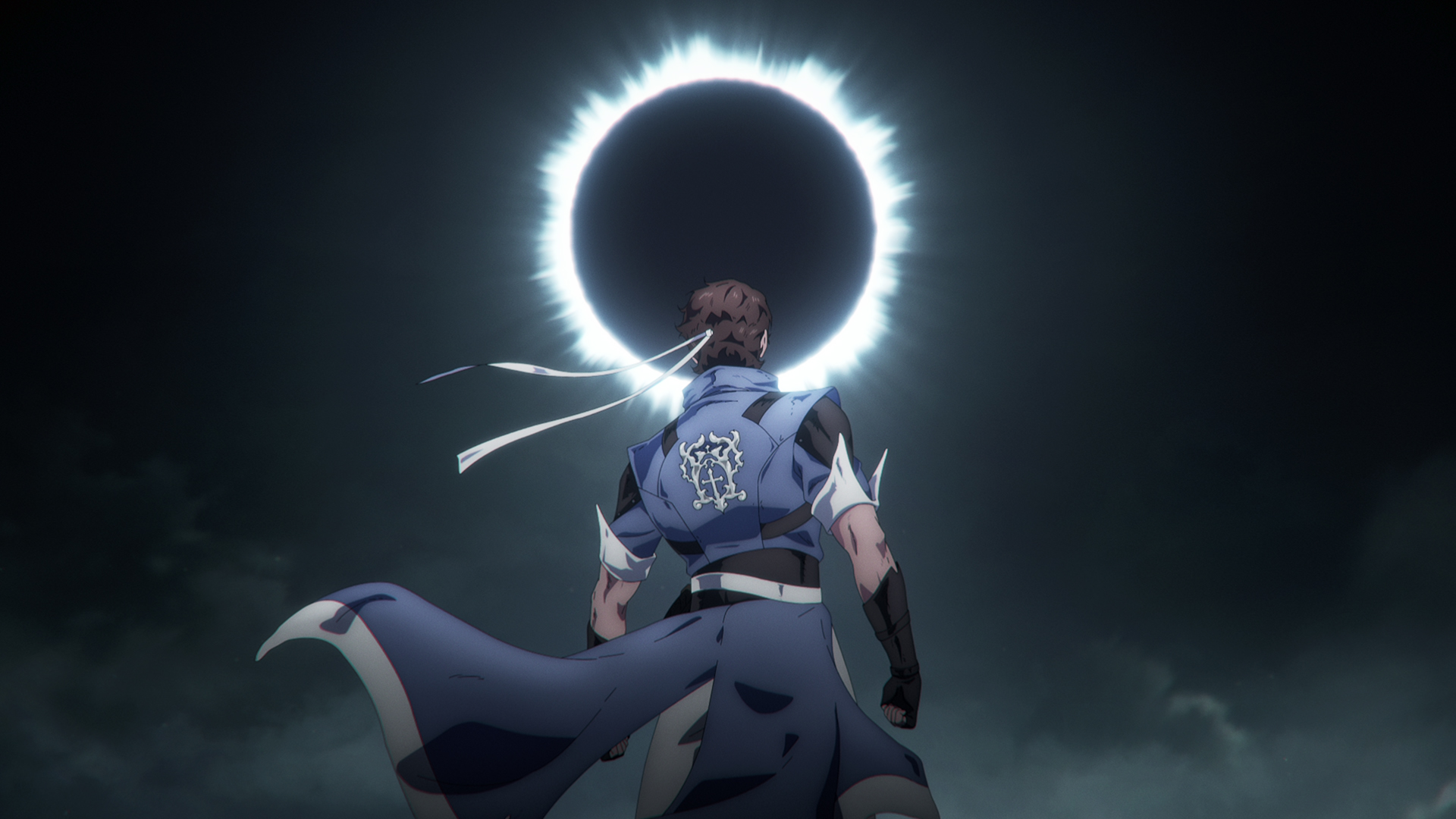Animated series Castlevania: Nocturne has received rave reviews since launching on Netflix last month, and a second season has already been greenlit. Its creator and showrunner is Clive Bradley, who sat down with us to discuss his inspirations, creative choices, the challenges of adapting a video game and the feedback from the fans.
Adaptations of video games are in vogue right now, particularly in animation. There’s DOTA: Dragon’s Blood, Carmen Sandiego, The Witcher: Nightmare Of The Wolf and Arcane (for the League Of Legends fans), to name a few.
And there was Castlevania, based on the Konami games. Written by Warren Ellis, it ran between 2017 and 2021, and was set in 15th-century Wallachia. Castlevania, the long-running and influential platform game series launched by Konami in 1986, follows the generations-long battle between the Belmont family and vampire lord Dracula. The Castlevania TV show told that story across four seasons.
The TV universe of Castlevania expanded last month with the Netflix release of Castlevania: Nocturne. Created by Clive Bradley and produced by Kevin Kolde, the new show is in the same universe but transports us forward in time to the French Revolution in 1792, primarily centred on the commune of Machecoul.
This 2023 series recounts the journey of Richter Belmont, the latest Belmont to wield the Vampire Killer whip, who was introduced in the 10th instalment of the game series. In the show, Richter and his adoptive family, Tera and Maria Renard, along with new allies from Saint-Domingue, battle to prevent a ‘vampire messiah’ from arising amid the tumult of the late 18th century.
Prior to working on Castlevania: Nocturne, Clive Bradley was well known for docudrama That Summer Day (which won a BAFTA), historical crime show City Of Vice, Icelandic mystery series Trapped, and the horror movie WΔZ, among others.
Beware: this interview assumes you have seen all eight episodes of Castlevania: Nocturne – there will be spoilers!
What have you been working on most recently and how did you go from there to Castlevania: Nocturne?
Clive Bradley: I recently worked on three seasons of the Icelandic crime show Trapped. The jump from an Icelandic crime show to an animation with vampires is quite big! Kevin Kolde had produced the original Castlevania series – Nocturne is a sort of a spin-off, sequel series – and Kevin had watched Trapped. It tells you a lot about him that he thought this might be a really interesting fit because what matters is story and character.
As it happens, I grew up reading a lot of fantasy, and I’m a big fan of vampire stories. So, in fact, that was more of a fit than Kevin knew! But that was how we first got together. There was a call with my agent; it was a gig I had to pitch for – I had to suggest my take on it.
I didn’t know the games, but I’d seen the earlier [Castlevania] show and liked it very much. There are two games in the mix for this new series: Rondo Of Blood and Symphony Of The Night. I knew Rondo Of Blood is set in 1792. I said, “Well, that’s the middle of the French Revolution! Why don’t we set it there?” Kevin liked that, and Netflix agreed, and that’s how it began.
Was the process very different, working on an animation, compared with working on a live-action show like Trapped?
Fundamentally, no. There are things I’ve had to learn about the process of animation, which is very slow. But the process of writing wasn’t different. Getting all eight episodes written for season one took less than a year.
The biggest difference for me, compared to Trapped, is that [Castlevania: Nocturne] was in the middle of the pandemic! We had a writers’ room but had to do it on Zoom. And because the animators are based in America, I met them for the first time only last month in New York.
Another difference is that this was my thing; I was showrunning it. With Trapped, it was somebody else’s show, and I was brought into that process.
The first Castlevania show had been written by only one person, but I wanted to bring in some other writers. So I put together a writers’ room.
I knew I wanted a character from Saint-Domingue, which is later Haiti. Therefore, her magic would be of West African origin because that’s where the enslaved people mainly came from. I was going to need some help with that. You could just have an advisor, but I thought, “Why don’t I see if there are some writers who would be interested?”
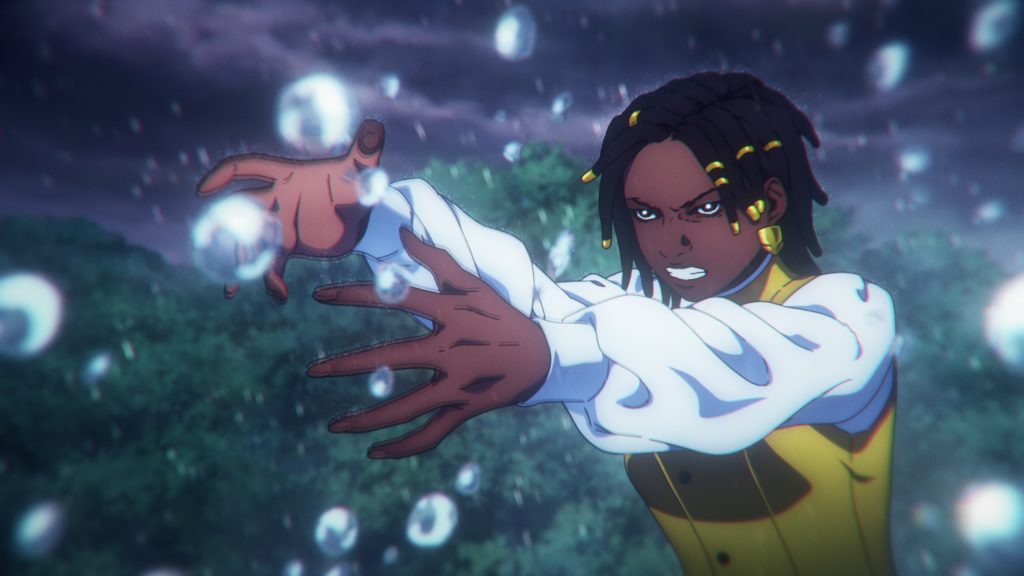
My agent put me in touch with writers through other agents. They’re all experienced in other fields; this was their first streaming television work. Three were great, and we were commissioned for eight episodes, so I thought that worked out well.
We didn’t have a budget for much, so for season one, we did a week on Zoom and worked out which episodes they would write. We had a week discussing the episodes in detail. They chose the episodes they wanted to write and we took it from there.
Zodwa Nyoni is a playwright. The first time we all met in person was when we went to see one of her plays at the Kiln Theatre. Temi Oh has written a novel and a short film. And Testament is a rapper and playwright, and he’s written a spec script for television, which I read. I read all their material and chatted with them, and they were all great. That’s how we put that together. The ‘room’ itself was a week on Zoom. But then, obviously, there’s a lot of communication while you’re all working on scripts. We know it’s been really good working well with each other. They’ve all worked on season two as well.
How much involvement did you have with the animators during the process?
Kevin [Kolde] and I are both executive producers. Kevin’s in Los Angeles. We have a weekly meeting over video with the lead animators in Austin, Texas. Part of our process is that, in tandem with the writing of the scripts, their team would be sending us designs. They would show us different options for characters and locations, and I get the final say in which designs to go for.
The animation process is that they do a kind of draft animation called animatics. They send me some of the scenes separately, but then there’s what they call a ‘stitch’, which is the draft rough animation of the episode, on which we give notes. Then they make changes and that version gets sent to Netflix to agree. Konami also gets sent notes and the scripts. And then it gets sent to Korea to be animated. Then, when the animations come back, there’s another round of notes.
You weren’t a huge player of the Castlevania games. But did you immerse yourself in the world and lore of the game?
I did quite a bit of reading up about it, especially the two games in particular. One of the difficulties in terms of working out a story is that in many of the games, including these two, Dracula was prominent. But in the original TV series, the Dracula story is kind of put to bed! Dracula gets a happy ending after season four. So I had to work out how – or whether – to handle Dracula. I started looking into other villains.
There were two. I researched the games and cherry-picked what I could use. Olrox is in the game, but he’s different. And there’s Erzsebet Báthory, who appears in a different Castlevania game with an Anglicised name. I knew who she was already: she’s a famous historical figure. I decided to treat her as the historical character (who’s supposedly the worst female serial killer in history – [folklore] turned her into a vampire).
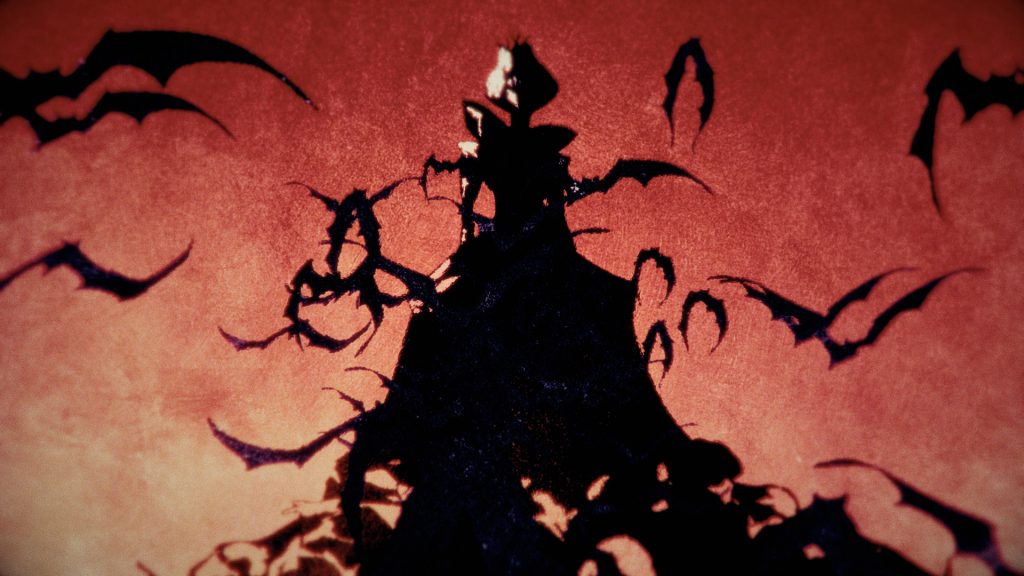
The other thing is that Kevin and the Deats brothers, who are the two directors, are fans of the game! So they’re always bringing stuff. For instance, in episode six, when Richter gets his magic back, fans of the game will recognise the music as Richter’s music. That comes directly from the Deats brothers. They know how to use things from the games creatively and in ways that will work even if you don’t know the games. It’s an exciting piece of music! But if you are a fan of the games, you’ll have an ‘Oh wow!’ reaction.
What has the reception been like among Castlevania fans?
It’s been a strange experience, to be honest. The show’s been very successful. There are a lot of people who love it.
I’ve tried to stop looking at social media because it’s too much to cope with. There certainly is a contingent among fans of the games (or people, at least, who say they’re fans of the games) who don’t like it. I saw a tweet about how the show’s original writer “Has more talent in his little finger than you have in your entire body”! So there’s been that kind of thing, or somebody threatening to kill himself in front of me…
There’s been a bit of ‘culture war’ around it. In particular, the most controversial character is our Annette. There is a character called Annette in Rondo Of Blood who is Richter’s girlfriend. She’s trapped in Dracula’s castle, and he has to rescue her in the game. Now, I was never going to do an eight-episode season, never mind two seasons or more, of Richter running around a castle rescuing a girl.
Because we wanted it to be in the French Revolution, I thought an important element to include is the Haitian Revolution. I think it’s a very important and often ignored element of the French Revolution’s history. The French Revolution abolished slavery, but the reason it abolished slavery was because the enslaved people abolished it themselves. And so I wanted a character to represent that, and we developed that idea.
I used the name Annette because it’s a French-sounding name. And so she’s not really the same character as in the game! You can imagine this could be a different character that uses the same name. But some people have been upset about that. We’ve had some hate. They’ve called it ‘race swapping’.
People have been a bit less bothered about Olrox, who we’ve made Mexica.
Equally, there certainly are fans of the game who quote chapter and verse about it and love what we’ve done.
One of the tasks in developing the show and its story is that, of course, the reason it exists at all is because of the game. So you want to please fans of the game. But it can’t only be for fans of the game. It has to have a broader appeal. There’s a significant fan base, but you need more to justify a Netflix show. You have to have something that will work for a wider audience. It has to be something on its own, and you have to find the logic of the story that you started to tell.
Sometimes, the problem with adaptations (especially if they aren’t very complex stories to begin with) is that if you keep trying just to come back to that, you’re going to lock yourself into a dead end.
What you do is you develop characters and then the characters have a logic. And the story has its own logic. And you have to allow that to happen, or it will fail on every level.
Please tell us more about Olrox. He seems to be this conflicted character! Was he fun to write?
Right in the first scene, when he talks to young Richter, I was already enjoying him! Here’s my thought process that led to the character and background of Olrox. The name seems to work for a Mexica background – although it’s not really Aztec – and when they designed him, I could tell, “He’s going to be lots of fun.” I like the idea that you meet him in the beginning, and people will think he is the ‘big bad’. Maybe Richter will be on a quest for vengeance against him. He’s the guy who killed his mother.
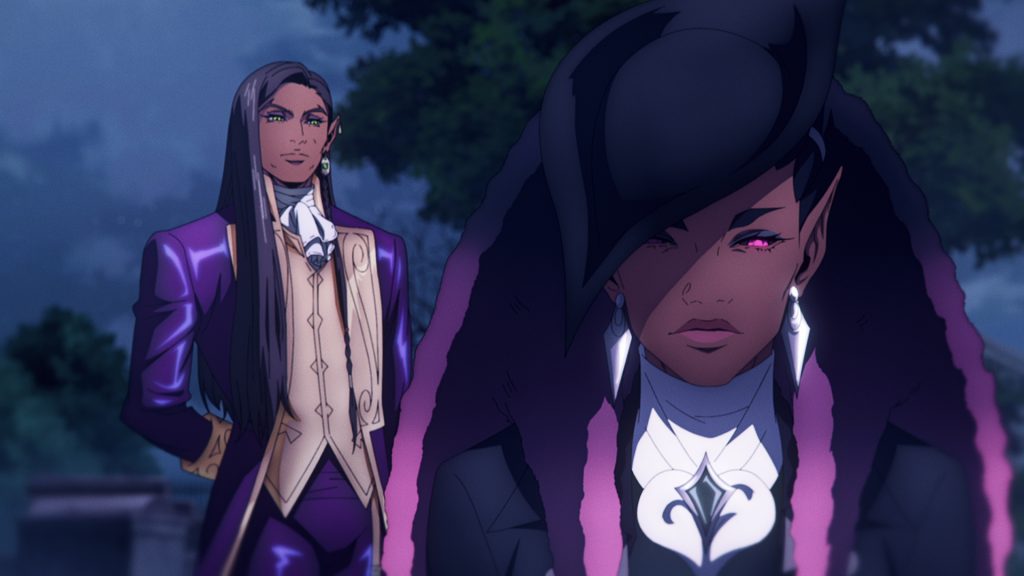
But in fact, he’s much more complicated and ambiguous than that. He’s definitely not on the side of Bathory! She’s mad. She wants to colonise America – and he’s seen that happen once already. He’s Mexica; he wants to protect his own. But he is also hedging his bets! He doesn’t want to reveal himself as being against her.
What are some of your personal influences? You mentioned fantasy and vampire fiction…
I’ve watched Buffy [the Vampire Slayer] from start to finish, I think, at least three times. One of the things that I love about it is the way it walks a line between being a teen show and dealing with quite complex issues. The characters are complex, the situations they face are complex and the moral questions they deal with are complex.
There’s the Scooby gang (obviously, that’s from Scooby Doo, but it’s the Buffy term for the team-up). Absolutely, I wanted that sense of them. In Castlevania: Nocturne, they’re quite young. One of the things different about this team from the old Castlevania show is that Trevor was a bitter, cynical drunk who doesn’t really want to get involved. But here, they’re kids.
So we have a bunch of kids who are out of their depth. Richter’s too cocky. He thinks he can handle everything, and he can’t. Maria is even younger than Richter and Annette. They’re all very obviously out of their depth. And there’s something very Buffy about that, in a way.
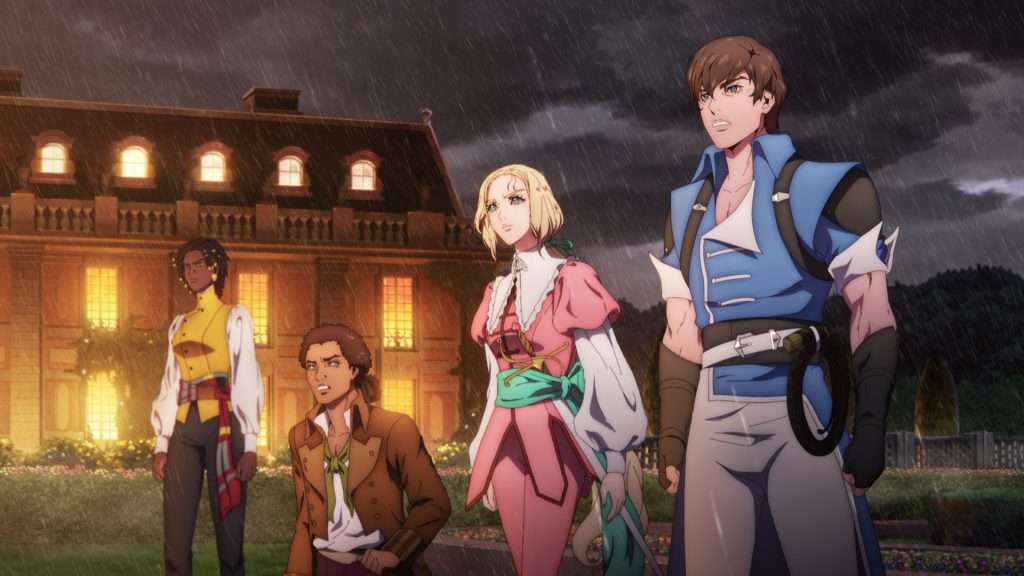
One influence you can see in Olrox is Anne Rice. I read the first six Anne Rice vampire novels, and I love them. There’s a lot of that in Olrox, and Drolta also has a touch of Anne Rice about her. Those particular vampires are quite ambiguous – and sexy!
Please tell us about the significance of the French Revolution setting. The vampires are on the side of the aristocracy. The Church also plays a big role in your story. What are the implications of all that?
Within the limits of there being vampires and monsters, it is kind of accurate. It’s set in the Vendée, where the counter-revolution developed. It started in 1792, although the Vendée War was the following year. That’s the context.
I very much enjoyed writing fantasy and thinking about how you combine fantasy and the real world. There’s the game, and there’s real history. I enjoyed finding ways to work on both. For instance, in episode three, the events you see in the woods are part of the history of the Haitian Revolution, which is still regarded as a great event in the history of Haiti.
One element of it was that the Church was a big issue in the French Revolution. There were whole sections of the Church that were opposed to the revolution.
This was part of our conversation with Kevin, who had been the producer of the old show. We knew that the vampires in this universe are aristocratic. In something like Anne Rice, this is often different: if you read The Vampire Lestat, in the book, he meets some vampires in Paris. They’re all living in graveyards and are kind of outcasts. And maybe I had an image of that, to begin with. But in conversation with Kevin, he clearly understood that in Castlevania, that’s not really who the vampires are. They would be part and parcel of the aristocracy. And so the rest of it flowed from that.
The Night Creatures are in the old Castlevania show, and the game. But they tended to be a bit gross-looking. In contrast, we wanted something a bit more beautiful. It fits with the story about [transformed singer] Eduard. It felt important that in his Night Creature form, you could still see the beauty of the character. He needed to be a beautiful Night Creature, preserving his voice, and you needed to see the sadness in his eyes and everything. And he couldn’t be stupidly different from all the other Night Creatures, so they changed a little, too.
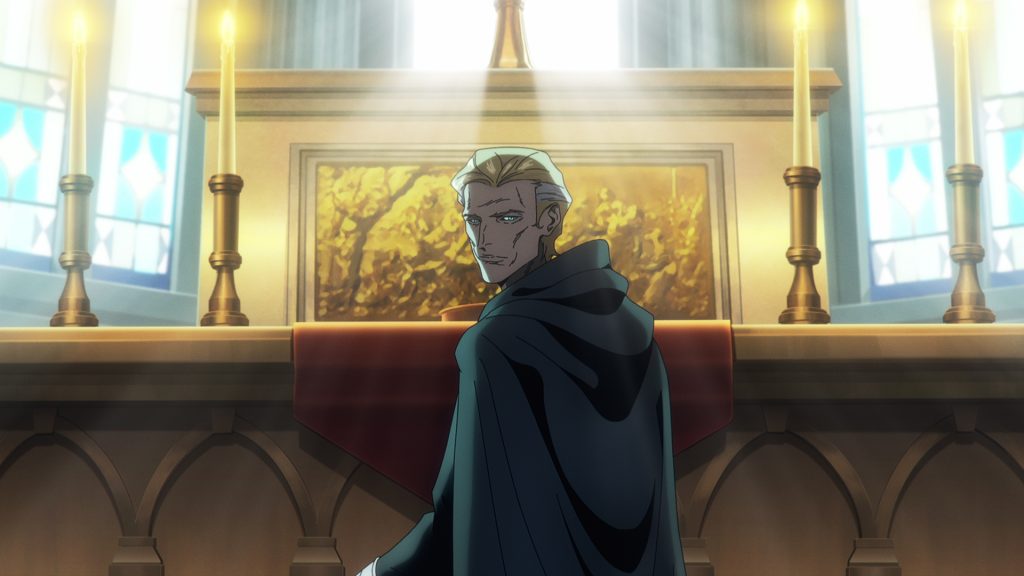
The Abbot is an interesting character. There’s been less complaint about the portrayal of the Church than I thought there might be! There is a side to the Abbot which is quite sympathetic. He’s a tortured man. He hasn’t simply thrown in his lot with the devil and said, “Who cares?” It’s an interesting conflict. He believes in what he’s doing. It’s not because he’s wicked.
I can’t remember when we decided that he was Maria’s father. It was in the mix from early on. It felt right. It came out of the fact that [her mother] Tera has found refuge here after fleeing from Russia. It makes you wonder what that refuge was – what exactly happened with her? When you know that, things start to fall into place.
Talk us through some of the other characters, please. You’ve got some great voice actors!
Alucard was always going to be in it right from the beginning of working on this. The question was just when. We decided to end it on a cliffhanger. If you’re going to have a cliffhanger, you might as well make it as good a cliffhanger!
So the appearance of Alucard was great, and the Deats did a wonderful job in that moment. There’s the animation and the musical composition and everything. It’s Alucard’s theme from the old show. For the fans, it’s been one of their favourite things. It’s James Callis, and he also voices Alucard in the earlier series, of course. I don’t know if you noticed, but in most episodes, the cast names come up at the start. But that doesn’t happen in episode eight because we didn’t want to spoil that James Callis’s Alucard was in the episode!
Then there’s Iain Glen, who’s perfect for Juste [Belmont, Richter’s grandfather]. Edward Bluemel plays Richter and, to me, is just absolutely the voice of Richter. Pixie Davies plays Maria Renard, and she’s very young. She’s wonderful. Zahn McClarnon, who pays Olrox, is fantastic.
And Thuso Mbedu, who plays Annette, is just fantastic. When we did the recording, she was in South Africa because she was making The Woman King – she’s the second lead in that, after Viola Davis. She was recording [Castlevania: Nocturne] in Cape Town, and we got to hear that bit where she has to cry after Eduard is killed. He’s killed, and she has to cry. And we heard it and were all like, “Oh my god!” So powerful. She was amazing. Everyone gets to get to have a good cry, actually, at some point! They’re all very good.
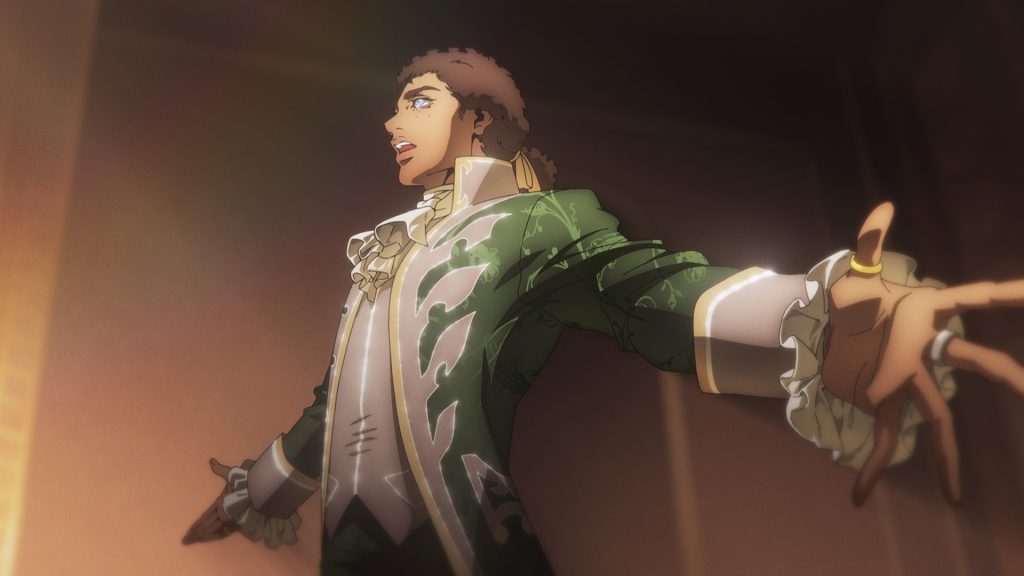
Sydney James Harcourt, who does all the singing, is so important. It was a gamble introducing all that opera – well, it’s not strictly opera, but classical singing. Does it work? For me, it totally does. And part of the reason it works is that Sydney is just fantastic.
All the others, too. We’re very, very happy with them. They were an amazing bunch of actors to get to do it.
Have you got a taste for adapting video games now? Can you imagine yourself adapting other big franchises?
I’ve certainly got a taste for fantasy! Over the years, I’ve developed a number of fantasy ideas which have never seen the light of day, so it’d be nice if this puts me in the running to do something there.
It’d be lovely to work on big game franchises. Obviously, it all depends on what the material is. One of the things that was great with this – and it’s a credit to Kevin Kolde and to Netflix – is that it is a very ‘free’ adaptation. They were very open to that and okay with it. Nobody at any level was saying, ‘Hold on a minute! You can’t do that.’ With any adaptation, there are things which you probably want to be more faithful to, because the story is already so great.
You can watch all eight episodes of Castlevania: Nocturne now on Netflix. The show has an official X (formerly known as Twitter) account, which you can follow for information. Disclosure: the writer of this article and the interviewee are related. Discover more about transmedia storytelling and the adaptation of video games IP at Pocket Gamer Connects London in January 2024.
Professional geek Dave is COO of Steel Media, the company behind Beyond Games. He oversees various events, marketing and editorial teams. Dave started his career writing game reviews in the 1990s and he’s since served as editor-in-chief of publications such as the official Microsoft magazine and entertainment mag SFX.



























